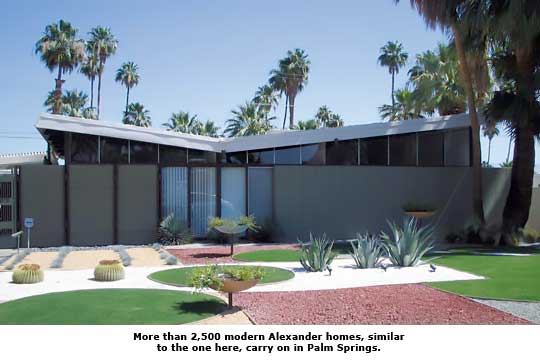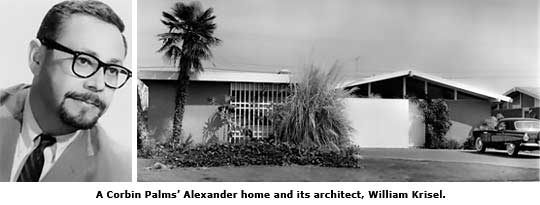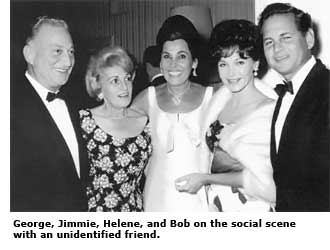Family Affair, Story Untold - Page 2
Bob was neither an intellectual nor a student, dropping out of the University of Southern California after a year or so, Krisel says. Bob, who had served in the Navy, went to work for his father, an accountant who had recently embarked on a career as a real estate developer. George, who was born in New York of Jewish parents from Russia and Poland, had gotten involved in real estate through a friend, developer Joe Dunas, Jill says.

"That was the period right after World War II, and there was a tremendous shortage of housing in Southern California," Krisel says. "And everybody and his brother -- lawyers to dentists to doctors -- all became developers."
George and Jimmie were from Brooklyn, where Bob was born, and were doing well when Krisel first met them, living in a fine old house in Los Angeles' Hancock Park. Jimmie's real name was Mildred, which she disliked. Bob was their only child.
Krisel, who never got to know George Alexander well, portrays him as the financier of the firm, wining and dining "the big owners of the savings and loans that he needed to finance construction."

Kitnick, who remembers when her grandparents were living in the penthouse of the Sunset Tower Building on West Hollywood's Sunset Boulevard, recalls her grandfather as a large, jovial man -- but one who was "very much in charge, the man behind the business. He taught my father everything he knew."
George was building standard stucco 'dingbats' when Bob joined the firm. Bob had no particular interest in modern architecture. But Bob was ripe to prove himself to his old man, and he quickly teamed up with Krisel to build "what I had learned at the architecture school at USC and what I had a leaning to, which was low-cost modern housing," Krisel says.

"Bob didn't like working for his dad. He was a go-fer," Krisel says. "His father tried to get him involved with all aspects of construction, financing, design. Bob was learning all that but it was strictly under his father's thumb."
"Bob thought, 'I'll be able to prove to my dad that I can do it. That's how it happened."
When Bob proposed building modern homes, Krisel says, his father replied, "'You guys are nuts.' Bob kept pushing and I kept making sketches and drawings. His father finally said, 'I have this three-acre lot. Put ten houses on it.'" That mini-tract in Los Angeles' San Fernando Valley was quickly followed by Corbin Palms, the Alexanders' first major modern subdivision. The houses, built beginning in 1953, cost less than the standard dingbats, earned greater profit per house, and sold well. Dad was impressed.
Soon, Krisel says, George Alexander was selecting sites throughout the Valley and Bob was handling the building. Alexander Construction was now firmly in the modernist camp and using designs by Krisel, of the firm Palmer & Krisel, exclusively.
Unlike builder Joe Eichler in Northern California, neither of the Alexanders was personally devoted to modern architecture. "I don't think Bob understood architecture so much as he was a builder," Krisel says. "What's the bottom line? And will they sell? And how much do they cost? As far as architecture, he left it to me."
By this time Bob and his wife Helene, who met in high school, were living in a traditional house with shingles and shutters at the Riviera Country Club in Pacific Palisades. Their furnishings ran to Early American. Helene was a beautiful woman, "absolutely a knockout," Krisel says, whose family, the Appels, were old-time builders in Los Angeles who considered the Alexanders upstarts. Bob was mad about her. "He just thought she was gorgeous, and she could do anything she wanted."

It was George who moved the family -- and the firm -- to Palm Springs. George and Jimmie went there in 1952 on the advice of his friend and doctor, George Kaplan, and loved the desert. And George Alexander noticed that, unlike the increasingly competitive San Fernando Valley, no one was building tract homes. "It was a more laid-back type of lifestyle," Krisel says, "and the competition was zero."
But it was a daring move. Could a desert playground for the rich and celebrated be turned into a haven for the middle class? When George proposed building homes aimed at middle-income, second-home buyers, Krisel says, "Everybody thought he was nuts."




